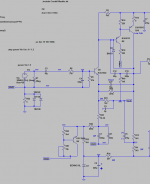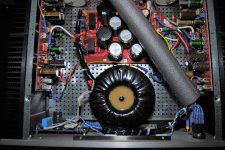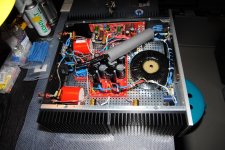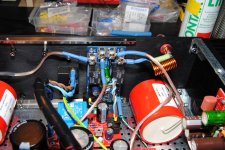Member
Joined 2009
Paid Member
This amp has some really good grip on the bass driver, very fast and precise. I haven't done all the tests yet but looking very good so far.
Do
Hardly can wait, I have pair PC boards (I hate SMD parts) so I kept postponing to do something with.
I also will build the USSA amp like yours.Maybe you can give some feedback on this amp compare the Class A type.
Greetings
True.... the best bass grip I heard in yearsThe bass-grip was a pleasant surprise to me. It's not as if I knew how to design that attribute into the amp, but when I first heard it on some big floor-standers I was floored !
Maybe you can give some feedback on this amp compare the Class A type.
Greetings
Hi gaborbela,
I will send you some feedback but on a PM, not the thread.
Ciao!
Do
Hi gaborbela,
I will send you some feedback but on a PM, not the thread.
Ciao!
Do
Thank you!
Greetings
Funny enough but not really at the same time, I was checking the first module and calibrating it to match the newly assembled one and it does work and calibrate properly, however, I was trimming the offset in order to trigger the speaker protection and realize that it always stays on, even with almost 2Vdc offset. The newly assembled module seem to trigger around 800mV... I'm thinking, I'll just bypass it and use an offboard speaker protection BUT this is not how I work... I'm curious to know what could be wrong with it... Could I have damaged it while conducting the tests before?
What could I check on the protection circuit to try and nail it down? Do you think the opto could be defective? one of the transistors and if yes, what voltage should be present at DC protection trigger state?
Thanks
Do
What could I check on the protection circuit to try and nail it down? Do you think the opto could be defective? one of the transistors and if yes, what voltage should be present at DC protection trigger state?
Thanks
Do
Member
Joined 2009
Paid Member
That doesn't sound right, the dc-trip is set by the Vbe drops of a pair of transistors, one will trip for -Ve offset, the other for +Ve offset.
If the protection is stuck in 'on' then we could have both FETs are failed short. This never happened for me, but it's theoretically possible if they were damaged. If the FETs are OK then the opto is OK too because it must be providing the gate voltage needed to turn them on. If you have a high impedance voltmeter and can probe the voltage at the output of the opto we can see if it's providing a gate drive voltage - if it is doing this even with large dc offset then the trigger circuit is not working, if it is not providing any gate drive voltage but the FETs are conducting then you know the FETs are pooched.
If the protection is stuck in 'on' then we could have both FETs are failed short. This never happened for me, but it's theoretically possible if they were damaged. If the FETs are OK then the opto is OK too because it must be providing the gate voltage needed to turn them on. If you have a high impedance voltmeter and can probe the voltage at the output of the opto we can see if it's providing a gate drive voltage - if it is doing this even with large dc offset then the trigger circuit is not working, if it is not providing any gate drive voltage but the FETs are conducting then you know the FETs are pooched.
Member
Joined 2009
Paid Member
Can you check (referring to the schematic in post #604) that R36 is actually 100k, if it is a much smaller value it might act to pull-up the base of Q15 and hold the output on despite a trigger condition.
The offset trigger pulls-down the base of Q15, turning it off, and denying current to the opto. To pull-down the base of Q15 it requires that either Q12 or Q13 be turned on. If you can check the parts around those devices we might home in on the issue. For example, R32 relays the output level to the trigger circuit - if it's open circuit then it won't trigger.
The offset trigger pulls-down the base of Q15, turning it off, and denying current to the opto. To pull-down the base of Q15 it requires that either Q12 or Q13 be turned on. If you can check the parts around those devices we might home in on the issue. For example, R32 relays the output level to the trigger circuit - if it's open circuit then it won't trigger.
I have been listening to this build for more than two weeks and after finding the good input cap it does sound exceptional but I am worried about it's stability... It does not accept any cable in the input.... A very well shielded cable works but a non shielded one provoques a nasty screeming medium pitched noise in one or both channels. (Sometimes it screems on both channels and sometimes only one whistles)
I am using a 10u dc blocking cap directly connected between the rca input and the amp board. I DID NOT put a 1meg ohm resistor R7 directly over the rca input to gnd.... can this be the issue ?
I am using a 10u dc blocking cap directly connected between the rca input and the amp board. I DID NOT put a 1meg ohm resistor R7 directly over the rca input to gnd.... can this be the issue ?
Attachments
Member
Joined 2009
Paid Member
Ignoring the schematic question for now.....Well, a screaming sound means the instability is relatively low frequency - which more or less counts out any instability related to the negative feedback loop or a high gm output device going off by itself. I doubt that there is any issue with the input base stoppers.
I have had low frequency instability before when playing with amps on the bench if I got any kind of unintentional feedback around the amplifier through poor grounding - you have to be very careful not to have currents from the output stage (or speaker) flow in the ground of the input signal (I once made an amp unstable simply by clipping on a scope probe earth wire to the wrong spot without realizing it was creating feedback via an earth loop). Another cause is proximity of wires - input wires to power supply or output wires - a shield will help only with electrostatic cross-talk but you can still get magnetic cross-talk. It seems that you have found electrostatic shielding to help with this issue but it might also be that the shielded cable is changing the grounding situation so I'm not sure if it's parasitic feedback to an unshielded cable or an earthing problem.
Can you share a bit more information about your set-up, a diagram or photo ?
I have had low frequency instability before when playing with amps on the bench if I got any kind of unintentional feedback around the amplifier through poor grounding - you have to be very careful not to have currents from the output stage (or speaker) flow in the ground of the input signal (I once made an amp unstable simply by clipping on a scope probe earth wire to the wrong spot without realizing it was creating feedback via an earth loop). Another cause is proximity of wires - input wires to power supply or output wires - a shield will help only with electrostatic cross-talk but you can still get magnetic cross-talk. It seems that you have found electrostatic shielding to help with this issue but it might also be that the shielded cable is changing the grounding situation so I'm not sure if it's parasitic feedback to an unshielded cable or an earthing problem.
Can you share a bit more information about your set-up, a diagram or photo ?
I tried the amp in two very different setups...
Initially I was able to trigger the scream by flicking the turntable switch on or by switching a tabletop lamp on that is also near the power amp.
Now in a friend's system, it started screaming directly with power on... could tame it with a change of cables....
But your first quote is very helpfull.... I will increase the output devices gate stoppers and review the miller cap....
Initially I was able to trigger the scream by flicking the turntable switch on or by switching a tabletop lamp on that is also near the power amp.
Now in a friend's system, it started screaming directly with power on... could tame it with a change of cables....
But your first quote is very helpfull.... I will increase the output devices gate stoppers and review the miller cap....
- Home
- Amplifiers
- Solid State
- TGM8 - my best amplifier, incredible bass, clear highs, no fatigue (inspired by Rod Elliot P3a)



